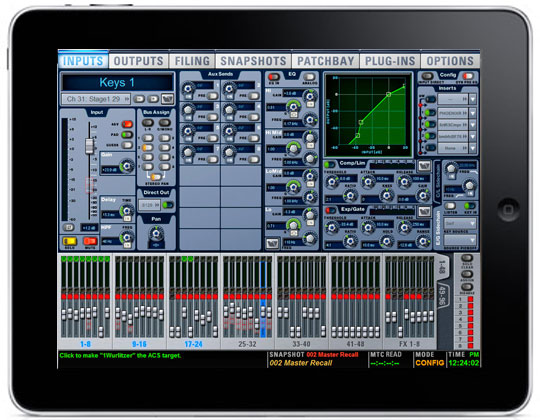GarageBand User Guide for iPad
In addition to recording, you can add Apple Loops and audio files to cells in an Audio Recorder or Amp row of the grid, or to an empty row. If your song has an empty grid, and has regions in Tracks view, you can import all of the regions from Tracks view to the Live Loops grid.
- Feb 03, 2016 A basic walkthrough for GarageBand 2.1's new Live Loop feature. This video shows how to use GarageBand on iPad Pro, which is a beginners guide for Live Loops. Making music is easy with GarageBand.
- Nov 22, 2017 A look at Live Loops. To get started, open up the free GarageBand app, create a new project, and tap Live Loops at the top of the screen. Like everything in GarageBand, Live Loops work on both iPhone and iPad. The easiest way to get started with Live Loops is.
Add an Apple Loop to a cell in an Audio Recorder or Amp row
GarageBand includes Alchemy, one of the world’s most advanced synthesizers. Explore hundreds of Apple‑designed Patches, perfect for EDM, Hip Hop, Indie, Rock, and Pop music. Use the expressive Transform Pad to morph between sounds in real time, or just have fun using the simple Chord Strips that help anyone play like an expert.
Tap the cell, then tap Loops.
The Loop Browser opens.
Do one of the following:
Tap Download button for the loop you want to add.
Drag a loop from the Loop Browser to the empty cell.
If the loop features a different instrument that the one originally used by the row, the icon for the row changes to a speaker icon.

Add an Apple Loop to a new, empty row
Tap the Add Row button below the track headers, then tap Loops.
The Loop Browser opens.
Do one of the following:
Tap the Download button for the loop you want to add.
Drag a loop from the Loop Browser to the empty cell.
Add an audio file to a cell in an Audio Recorder or Amp row
Tap the cell, then tap Loops.
The Loop Browser opens.
In the Loop Browser, tap Audio Files.
Select the audio file you want to add.
Do one of the following:
Tap Download button for the audio file you want to add.
Drag an audio file from the Loop Browser to the empty cell.
GarageBand User Guide for iPad
GarageBand includes a set of Apple Loops you can use to easily add drum beats, bass lines, rhythm parts, and other sounds to a song. Loops contain musical patterns that can be seamlessly repeated over and over. You can extend a loop to fill any amount of time. When you change the tempo or key of a song, Apple Loops also change to match the new tempo or key.
You can quickly find loops in the Loop Browser and preview them to find the ones you want to use in your song. You can specify loops as favorites and use them as a starting point for many of your songs. Audio loops are blue, Touch Instrument loops are green, and Drummer loops are yellow.
Recording With Garageband Ipad
You can download sounds packs containing more Apple Loops in the Sound Library.
Open the Loop Browser
Tap the Loop Browser button in the control bar. The Loop Browser button is available only in Tracks view.
Find loops using keywords
Search by instrument: Tap Instruments, then tap an instrument in the grid.
Search by genre: Tap Genres, then choose a genre from the list.
Search by descriptor: Tap Descriptors, then choose one or more descriptors from the list. Descriptors are listed in contrasting pairs.

The results list shows loops that match your search criteria.
You can narrow search results by using instruments, genres, and descriptors together. The results show only those loops that match all the selected keywords.
Specify and access your favorite loops
To specify a loop as a favorite, tap the Favorite button for the loop in the list of search results.
To access your favorite loops, tap the Favorites button near the upper-right of the Loop Browser.
Search for loops by name
Tap the search field in the upper-right corner of the Loop Browser.
Type the name you want to search for, then tap Search on the keyboard.
Matching loops appear in the results list.
Find loops using filters
Tap Filter by, then do any of the following:
Tap Sound Pack, then select one or more sound packs.
Tap Type, then select Audio Loops, MIDI Loops, or Drummer Loops.
Tap Scale, then tap a scale mode.
Tap Apple Loops in the upper-left corner to view the filtered results in the Loop Browser.
To return to the Loop Browser, tap Reset Filter.
Add a loop to the song
Drag a loop from the results list to an empty part of the Tracks view screen. Align the left edge of the loop with the bar or beat (on the ruler) where you want it to start playing.
The loop extends to the end of the current song section, or to the beginning of the next region in the track.
You can also drag:
Audio loops to an Audio Recorder or Amp track
Drummer loops to a Drummer track with the same drummer
Touch Instrument loops to a track that uses the same Touch Instrument
The loop replaces any existing regions in the same part of the track.
Preview a loop

Tap the loop in the results list.
Tap the loop again to stop the preview, or tap a different loop.
Reset the Loop Browser keywords
How To Use Garageband Looping On An Ipad Youtube
Tap Reset Keywords.
Any keyword selections are cleared. You can now select a new keyword.



